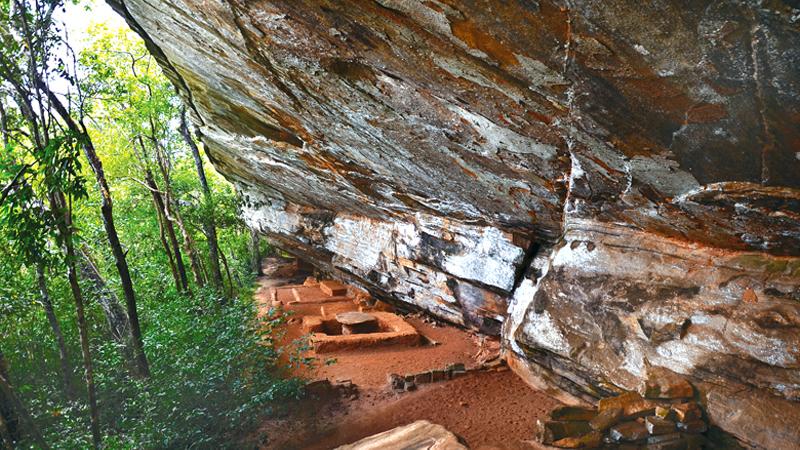
A little beyond the junction of Hulannuge, is Tharulengala where a historic Tharulengala forest hermitage rises majestically against a backdrop of lush greenery. The place is another sample of ancient Digamadulla. Situated on a rocky boulder called Karadahela, the site is in close proximity to the beautiful Hulanuge tank. In ancient times, this place was known as Karadahela Vihara and also Habutagala Vihara. The hermitage covers around 20 acres of thick forest where numerous stone ruins have long since been buried by rubble and time.
 Hulannuge is a farming colony established in early 1943. The animal infested forest engulfed the Karadahela Vihara. Even today leopards reign in this area, while elephants and sloth bears roam free. We are told the story of a bhikkhu who died by being attacked by a sloth bear.
Hulannuge is a farming colony established in early 1943. The animal infested forest engulfed the Karadahela Vihara. Even today leopards reign in this area, while elephants and sloth bears roam free. We are told the story of a bhikkhu who died by being attacked by a sloth bear.
Hulannuge, bordering the areas of the Eastern Province, had constantly faced terrorist threats during the battle against terrorism. The village was attacked by the LTTE which killed several villagers. Some have lived to tell the gruesome tales.
However, they say the dark times are over and they have fresh hopes and aspirations about their future.In the 1940s, the whole area was an animal – infested jungle and if anyone ventured into its folds it was for hunting. The Karadahela Vihara is buried in the thick jungle there.
Thick jungle
This historic temple is said to have been built by King Kawantissa, who ruled the Kingdom of Ruhuna. The ruined structures show how the place was developed over time.
We enjoyed the drive down the picturesque road from Moneragala to Pottuvil in the Eastern part of the Ampara District. The sight ahead, through the vehicle windscreen, of the shrub jungle and thick forest of the much famed Lahugala against the mild rays of the sun was beckoning us.
Coming from Lahugala, where we stayed overnight in the Banamaduwa of Magul Maha Vihara at Lahugala, we rose early to reach our next destination.
Our moods changed like the weather as we passed acres of lush green forest on either side of the Hulannuge- Pottuvil road.
Shrub jungles and farming lands filled the landscape. The gentle breeze was rejuvenating in the early morning as we headed for Hulannuge, which however, was not my destination. It was merely a scenic locale that we stopped by.
Parking our jeep in the slope of the hill, we began to climb the Karadahela hill and a few metres ahead of the cave we found a stone inscription.
Towards the mid-section of the hill, through bushes of wild flowers, we glimpsed a cave that had been converted into a shrine. The cave was drip-ledged with brick walls built around it. Today, the walls have disappeared. The cave is about 175 feet long and is about 35 feet in height. It houses a 41-foot long Buddha statue built with bricks and clay. The reclining statue has been severely damaged by treasure hunters.
Buddhist shrine
However, no doubt in ancient times, when the Kingdom of Ruhuna was flourishing it was probably a magnificent Buddhist shrine which has decayed over time. Evidence shows that Veddhas lived in this cave in early times where their paintings are still seen.
The resident bhikkhu in the Vihara told us that the front view of the Buddha statue was turned to the East to catch the first rays of the rising sun in the East coast. Adjoining the main cave is an abode where the chief bhikkhu lived.
This is called a Kuti, a small room where the bhikkhu meditates and masters the Buddhist doctrine. Here we saw a small but well-cleaned shrine room which contained several Buddha statues and Ola leaves.
A small chaitya and a pond lie on the summit of the Karadahela hill. The chaitya was being renovated when we visited the place. It resembled a Sanchi stupa in India, although smaller in size.
When we climbed to the top of the hill, we had a view of the entire Eastern Province and the Kumana sanctuary as far as the eye could see.

The striking feature of this place was its unique cave believed to be the longest cave in Sri Lanka.
The magnificent cave which lies on the summit of the hill is 512 feet in length. The cave is being used for meditation by monastic bhikkhus. Long pathways and abodes are built inside the cave for the use of bhikkhus.
The forest canopy in the vicinity of the cave became an ideal place for meditation. There are also several drip-ledged caves scattered on the Karadahela hill. All of these are used by monastic bhikkhus for meditation. Several inscriptions have been found near the site.
On the Eastern side of the hill are several ruined structures believed to have been vandalised by treasure hunters.
The flight of steps which lead to the top of the summit show signs of decay. Today, the place is called the Tharulengala forest hermitage administrated by the chief bhikkhu of the Kudumbigala forest hermitage. Bhikkhus of the Kudumbigala hermitage had taken refuge here during the battle against terrorism.
Kudumbigala lies around 30 kilometres west of the Kumana jungle in the Yala East National Park and belongs to the 3rd century and is famed as a reputed Buddhist shrine in the East.
